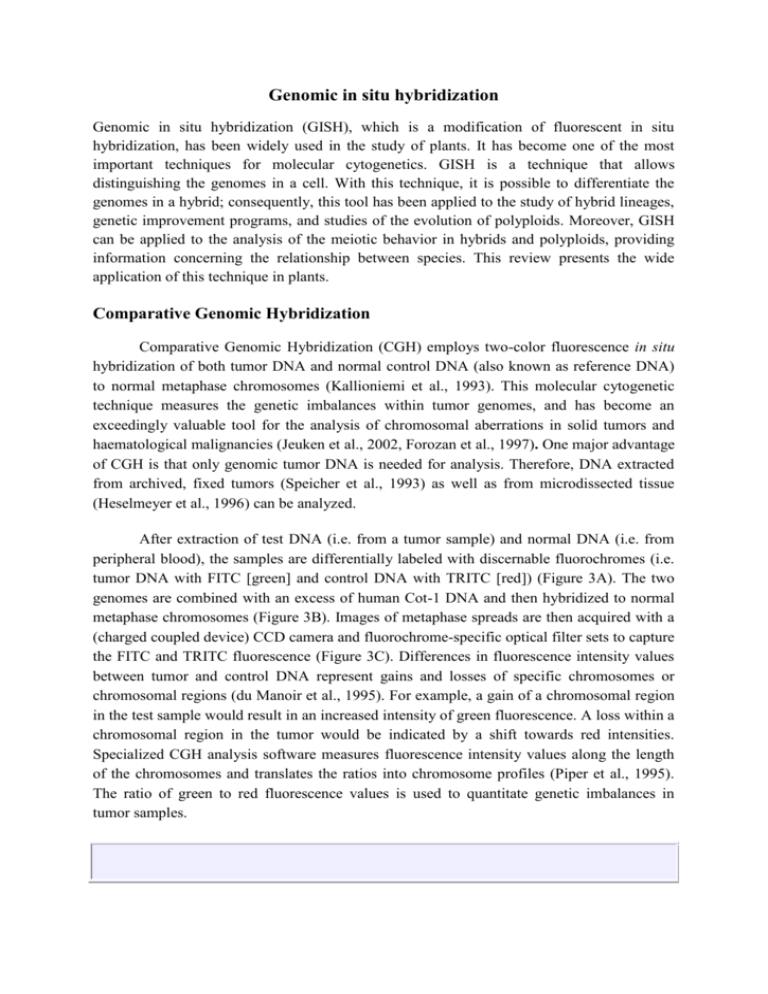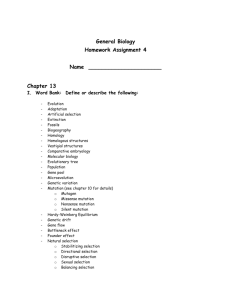gish & ribosome substr
advertisement

Genomic in situ hybridization Genomic in situ hybridization (GISH), which is a modification of fluorescent in situ hybridization, has been widely used in the study of plants. It has become one of the most important techniques for molecular cytogenetics. GISH is a technique that allows distinguishing the genomes in a cell. With this technique, it is possible to differentiate the genomes in a hybrid; consequently, this tool has been applied to the study of hybrid lineages, genetic improvement programs, and studies of the evolution of polyploids. Moreover, GISH can be applied to the analysis of the meiotic behavior in hybrids and polyploids, providing information concerning the relationship between species. This review presents the wide application of this technique in plants. Comparative Genomic Hybridization Comparative Genomic Hybridization (CGH) employs two-color fluorescence in situ hybridization of both tumor DNA and normal control DNA (also known as reference DNA) to normal metaphase chromosomes (Kallioniemi et al., 1993). This molecular cytogenetic technique measures the genetic imbalances within tumor genomes, and has become an exceedingly valuable tool for the analysis of chromosomal aberrations in solid tumors and haematological malignancies (Jeuken et al., 2002, Forozan et al., 1997). One major advantage of CGH is that only genomic tumor DNA is needed for analysis. Therefore, DNA extracted from archived, fixed tumors (Speicher et al., 1993) as well as from microdissected tissue (Heselmeyer et al., 1996) can be analyzed. After extraction of test DNA (i.e. from a tumor sample) and normal DNA (i.e. from peripheral blood), the samples are differentially labeled with discernable fluorochromes (i.e. tumor DNA with FITC [green] and control DNA with TRITC [red]) (Figure 3A). The two genomes are combined with an excess of human Cot-1 DNA and then hybridized to normal metaphase chromosomes (Figure 3B). Images of metaphase spreads are then acquired with a (charged coupled device) CCD camera and fluorochrome-specific optical filter sets to capture the FITC and TRITC fluorescence (Figure 3C). Differences in fluorescence intensity values between tumor and control DNA represent gains and losses of specific chromosomes or chromosomal regions (du Manoir et al., 1995). For example, a gain of a chromosomal region in the test sample would result in an increased intensity of green fluorescence. A loss within a chromosomal region in the tumor would be indicated by a shift towards red intensities. Specialized CGH analysis software measures fluorescence intensity values along the length of the chromosomes and translates the ratios into chromosome profiles (Piper et al., 1995). The ratio of green to red fluorescence values is used to quantitate genetic imbalances in tumor samples. Figure 3 : Schematic representation of Comparative Genomic Hybridization. (A) CGH begins with the isolation of both (1) genomic tumor DNA and (2) DNA from an individual with a normal karyotype (reference or control DNA). The two genomes are differentially labeled such that, for instance, the tumor DNA can be detected with a green fluorochrome (FITC) and the control DNA with a red fluorochrome (TRITC). (3) The differentially labeled genomes are then combined in the presence of excess Cot-1 DNA. (B) Both the probe and karyotypically normal target metaphase chromosomes are heat denatured prior to hybridization for a 24-72 hour period at 37�C. (C) Following a series of detection steps, metaphase chromosomes are imaged by epifluorescence microscopy with DAPI, FITC and TRITC filters consecutively. (1) The differences in fluorescence intensities along a chromosome are a reflection of the actual copy number changes in the tumor genome relative to the normal reference. The result of the hybridization shows gains and losses; in the event that a specific chromosome region is lost in the tumor, the color of that region is shifted to red. A gain would be represented by an increased intensity of the green fluorescence. (2) A minimum of 5 metaphases (or 10 copies of each chromosome) are analyzed to determine an average ratio profile. A ratio of 1 represents an equal copy number in the tumor and the reference genome. The vertical lines to the left and right of the chromosome represent a loss (< 0.8) and a gain (>1.2), respectively. Application Genomic in situ hybridization (GISH) was used to study somatic chromosomes of parental and progeny plants. Genomic in situ hybridization (GISH) is a molecular cytogenetic technique which now allows chromosomes from different parents or ancestors to be distinguished by means of differential hybridization of entire genomic probes Ribosomal Subunits The ribosome has been under the scrutiny of scientists for decades. Electron microscopy has yielded an increasingly detailed view over the years, defining the overall shape of individual ribosomes and differences in this shape for ribosomes from different species, More recently, detailed electron micrograph reconstructions have studied the interaction or ribosomes with messenger RNA, transfer RNA and the protein elongation factors. This legacy of morphological work lays the groundwork on which the atomic structures may be understood. Ribosomes are composed of two subunits: a large subunit, shown on the right, and a small subunit, shown on the left. Of course, the term "small" is used in a relative sense here: both the large and the small subunits are huge compared to a typical protein. Both subunits are composed of long strands of RNA, shown here in orange and yellow, dotted with protein chains, shown in blue. When synthesizing a new protein, the two subunits lock together with a messenger RNA trapped in the space between. The ribosome then walks down the messenger RNA three nucleotides at a time, building a new protein piece-by-piece. The Large Subunit The large subunit contains the active site of the ribosome: the site that creates the new peptide bonds when proteins are synthesized. In this view, the messenger RNA would run horizontally in the groove across the middle. This structure, along with several other structures with inhibitors bound, provide strong evidence that the ribosome is a ribozyme. Enzymes typically use amino acids to catalyze chemical reactions, but the ribosome appears to use an adenine RNA nucleotide to perform its synthetic task. The large subunit is composed of two RNA strands: a long one and a shorter one . Dozens of proteins bind on the surface of the ribosome. Many have long, snaky tails that extend into the body of the ribosome, gluing the RNA strands into their proper shape. The Small Subunit The small subunit is in charge of information flow during protein synthesis. It initially finds a messenger RNA strand and, after combining with a large subunit, ensures that each codon in the message is paired with the anticodon in the proper transfer RNA. The messenger RNA is thought to enter through a small hole (seen here on the left side of the molecule) and then extend up into the "decoding center" in the cleft between the "head" at top and the "body" at the bottom. The messenger RNA does not have to thread through this hole like a needle, however, because the hole is actually formed by a loop of the ribosomal RNA, which can open like a latch to admit the messenger. Ribosome locations Ribosomes are classified as being either "free" or "membrane-bound". Free ribosomes Free ribosomes can move about anywhere in the cytosol, but are excluded from the cell nucleus and other organelles. Proteins that are formed from free ribosomes are released into the cytosol and used within the cell. Since the cytosol contains high concentrations of glutathione and is, therefore, a reducing environment, proteins containing disulfide bonds, which are formed from oxidized cysteine residues, cannot be produced within it. Membrane-bound ribosomes When a ribosome begins to synthesize proteins that are needed in some organelles, the ribosome making this protein can become "membrane-bound". In eukaryotic cells this happens in a region of the endoplasmic reticulum (ER) called the "rough ER". The newly produced polypeptide chains are inserted directly into the ER by the ribosome undertaking vectorial synthesis and are then transported to their destinations, through the secretory pathway. Bound ribosomes usually produce proteins that are used within the plasma membrane or are expelled from the cell via exocytosis. Function: The ribosomes plays a very important role in protein synthesis, which is the process by which proteins are made from individual amino acids. Without the ribosomes the message would not be read, thus proteins could not be produced. Therefore, ribosomes play a very important role in role in protein synthesis.








